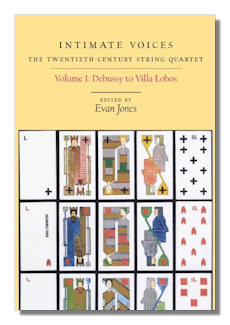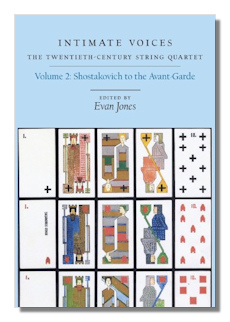
The Internet's Premier Classical Music Source
Related Links
-
Introduction
Acoustics
Ballet
Biographies
Chamber Music
Composers & Composition
Conducting
Criticism & Commentary
Discographies & CD Guides
Fiction
History
Humor
Illustrations & Photos
Instrumental
Lieder
Music Appreciation
Music Education
Music Industry
Music and the Mind
Opera
Orchestration
Reference Works
Scores
Thematic Indices
Theory & Analysis
Vocal Technique
Search Amazon
Recommended Links
Site News
 Book Review
Book Review
Intimate Voices - The Twentieth Century String Quartet

Volume 1:
Debussy to Villa-Lobos
Evan Jones, editor
University of Rochester Press, 2011.
xxi + 295pp
ISBN-10: 1580462294
ISBN-13: 978-1580462297
Dating from 1910, "Intimate Voices" (or "Voces intimae"), of course, is the five-movement string quartet by Sibelius – one of the most elaborate and distinguished pieces of its type. It's the title chosen by associate professor of music theory at Florida State University College of Music, Evan Jones, for this superb two-volume study of the twentieth century string quartet from Boydell imprint, University of Rochester Press, just reprinted digitally. The two volume hardback edition contains a total of 600 substantive pages devoted to the origins, contexts, purposes, instrumental use, development, conventions, performing practices, scoring, structures, external (and internal) references, and possible future of the medium.
Jones himself contributes but a single chapter… that on Xenakis, in the second volume. His achievement, though, is to have conceived, commissioned and aggregated the contributions of some dozen and a half specialists in their fields so as to make a unified and eminently readable narrative and set of studies amounting to what must be considered the most thorough, authoritative and comprehensive study of modern chamber music. At US$100 for the two volumes, it's reasonably enough priced (and the standards of production are up to the Publisher's usual high standards) to be recommended without hesitation.
Each volume (the two are divided into composers from Debussy to Villa-Lobos; then Shostakovich to the current avant-garde) is in three parts. In volume I these are: "New Voices from the Old World" (dealing with the adaptation and replacement of tonal writing), the Second Viennese School, and "Inherited and Indigenous Traditions". In volume II "Motive, Quotation and Form" (making the implicit case for a re-examination of (four) somewhat conservative, neo-classical composers – Britten, Shostakovich, Villa Lobos and Prokoviev), the European avant-garde, and the string quartet in America. These parts each comprise between two and five chapters; each is written by its corresponding specialist. These groupings – by nationalities, the relationships between composers and the (sometimes consequent) approaches that they have in common – make very good sense. Although there is a broad chronological organization across the two volumes, of course, such further grouping only aids in our understanding.
The two books of Intimate Voices The Twentieth Century String Quartet are not mere guides, descriptions or glorified or expanded program notes to the repertoire. Rather, each contributor skillfully, sensitively and intelligently both sets the music s/he is considering in the widest historical and musical context – especially looking forwards and backwards in and across the genre – and covers the particularity of the works from the corresponding individual perspective. This is not to say that greater significances are overlooked. They're not: Babbit's Second is called the "Apotheosis of the Trichord" [Volume II, pp 215-224]; the exact dissolution of tonality in Schoenberg's Third [Volume 1, pp 144-157]; and the implication for a Modernist milieu in the "rotational" motives of Sibelius' work [Volume I pp 30-37]. Indeed, Jones explicitly tethers all the contributions (and contributors) to such fundamental considerations as enable us better to understand and appreciate how the genre of the string quartet works at all regardless of historical epoch… sonorities, conventions, the four-player dynamic etc. He and his contributors also approach issues of performance; so much so and so well that the books would make useful reading for players as well as listeners, composers and others.
At the same time, each chapter is based upon substantial factual information… works are listed, biographies sketched, performances alluded to and sources mapped. This is in addition to the at times minute, always painstaking and often highly complex (yet always transparent) descriptions of works, movements, passages and – where helpful – individual phrases. But always in the service, not of mere description, but explanation of the works' places in the repertoire, of new ground broken, of the string quartet tradition advanced, and of the always essentially musical strengths of quartet writing that's shown by this study to be continually re-inforced by the greatness of the composers under consideration.
You could pretty much pick up any chapter and study it by itself. Though for serious engagement some sort of method as implicitly suggested by the book's progression is required. The examples, prose and contributors' arguments are at times necessarily dense, for all their lucidity and conciseness, and require close attention for full understanding. You would that way gain great insight into a composer's (or school's) achievements. But it is in following the broader development of the medium across a century that will afford the reader the greatest insight and pleasure because – as Jones makes clear in his preface (and indeed in his title) – the characteristics of the string quartet as a medium, a vehicle for musical expression, are sufficiently strong (perhaps as strong and enduring as any other, save song) to allow, support and sponsor the kind of development, experiment, consolidation and re-invention that have taken place in the last hundred years; and is so richly and comprehensively examined in Intimate Voices The Twentieth Century String Quartet. It's not an encyclopedia, or a guide, remember. It doesn't aim at exhaustive coverage of every work in the medium. But what it does detail explains much more about "Four intelligent people conversing with each other" (in Goethe's phrase) than perhaps a linear compendium might have done. Above all perhaps, this study demonstrates that the genre is as vibrant and likely to continue to develop as it ever was.
Intimate Voices The Twentieth Century String Quartet is very well illustrated with score extracts, quotations, tables and always apposite footnotes. The index is excellent and reflects the homogeneity of the final aggregation of this total of 20 separate contributions from almost as many contributors. If you're looking both to understand how the string quartet has developed and is still developing since the turn of the last century, and which many characteristics this exemplifies of the medium, there is no better way than to read this two volume study.
Copyright © 2011 by Mark Sealey.





















